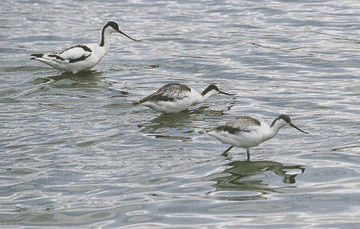Avocet (Recurvirostra avosetta)

Avocet © David Platt
This much sought-after wader, the emblem of the Royal Society for the Protection of Birds, has been extending its range for many years. Avocets have regularly bred in Suffolk since 1963, Norfolk since 1977, Kent since 1986 and Yorkshire since 1994. There were sporadic breeding records in the 1990s in Dorset and inland in London, Cambridgeshire and Leicestershire (Brown & Grice 2005). Then in 2001 came the first breeding record in northwest England, when a pair bred at Leighton Moss, north Lancashire; their first attempt failed, but they persevered with a second clutch of three eggs, two of which hatched and one chick fledged. By 2004, the Lancashire population was up to 24 pairs and Avocets were breeding in 13 counties in England and Wales (Holling et al 2007).
Cheshire and Wirral shared the excitement of the species’ exploration of new sites. In 1999, two appeared at Sandbach Flashes on 1 May, displaying and copulating to 6 May, but did not nest and then left. It seemed like that was that: in 2000, there were just two records of single birds in the Frodsham Marsh area, and the species was not even recorded in the county in 2001.
Then, in 2002 a pair was present for four weeks at Inner Marsh Farm (SJ37B), displaying, copulating and nest-scraping but not laying any eggs there. However, during their periodic absences from the RSPB reserve, they had taken a liking to a disused ICI lagoon adjacent to the Weaver Bend (SJ57E) and laid an egg in a scrape there. They abandoned this egg during cold, wet and windy weather at the beginning of May and returned to Inner Marsh Farm for ten days. The pair finally went back to Weston Lagoon on 11 May and laid four eggs from which the chicks hatched on 6 June. On 14 June the adults obligingly took them into public view on the bank of the River Weaver, where they remained until all four young fledged, first flying on 11 July, a perfect outcome celebrated with two of the chicks and one of their parents starring on the front cover of that year’s Cheshire and Wirral Bird Report. The family party went back to Inner Marsh farm for a day at the end of July then left the county (Platt 2002).
In 2003 three pairs bred at the same site, at least six chicks hatched but all the young birds were predated by Magpies and gulls. During this Atlas period, in 2004 up to six birds were present from 2 March to 8 April, with seven on one day, and one pair stayed in the vicinity of the Weaver Bend throughout the breeding season until 10 July. They were seen copulating and nest-scraping on Frodsham Marsh no.6 bed (SJ47Y) but no eggs were laid. In 2005, up to six birds were at the Weaver Bend from 20 March to 28 March after which they deserted the site and left the county, but three birds were at Inner Marsh Farm from 13 May to 2 June. In 2006 the RSPB was rewarded with a pair nesting at their Inner Marsh Farm reserve, four chicks hatching by 21 May and three of them fledging by 27 June.
It is not known where these birds have wintered. Increasing numbers of British birds use south coast estuaries, where they are joined by some birds from continental Europe, but others migrate as far as France, Portugal or south of the Sahara to Senegal and Guinea. Avocets have occasionally been recorded in the county during winter, most recently on the Dee off Heswall from 18 December 1994 to 1 January 1995.
For many years it had been thought that the habitat and food requirements of Avocets were stringent, the adults and chicks needing shallow saline lagoons that did not dry out during the summer. Perhaps they have changed their habits, but it is now clear that they can use a variety of freshwater pools provided that grazing or flooding maintains sparse or low vegetation; they need water up to 15 cm deep over soft sediments rich in aquatic invertebrates. This more relaxed requirement has allowed them to expand widely across England and Wales. Avocets do not breed until two or three years of age but immature birds may prospect new sites, and once they have bred at a location, adults tend to return in subsequent years (BTO Second Atlas). These features of their breeding biology, along with their colonial nature, have led to Cheshire and Wirral being able to enjoy Avocets’ presence during the last decade.
Sponsored by Graham Hewitt in memory of Ian May, a fellow rambler, ornithologist and good friend

